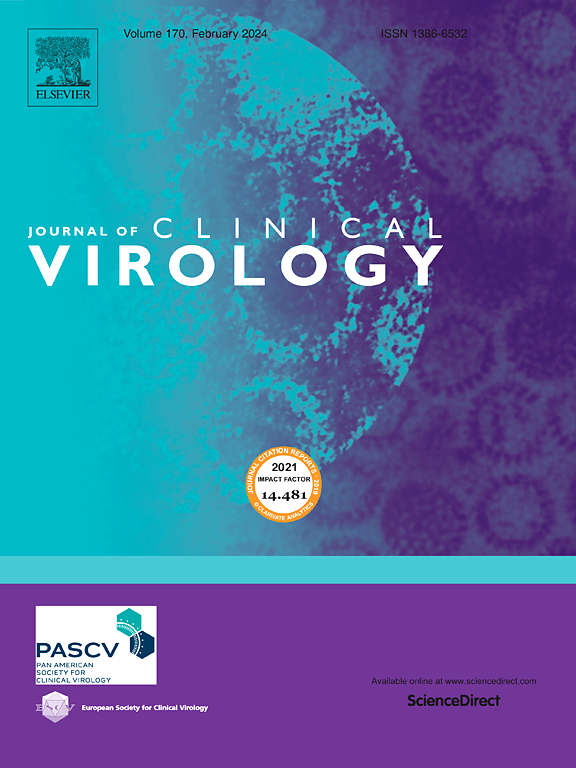雅培 Alinity 丙型肝炎抗原下一步测定在美国城市急诊科人群中的性能评估。
IF 4
3区 医学
Q2 VIROLOGY
引用次数: 0
摘要
导言:HCV抗体检测已被用于筛查HCV,但急性感染的确诊则依赖于RNA或核心抗原检测。本研究的目的是在美国急诊科人群中比较包括 RNA 检测在内的五种 HCV 检测方法的性能:方法:对约翰霍普金斯大学急诊科的 708 名自述感染 HCV 风险增高并征得同意的患者计算临床性能指标。使用 89 份来自市售血清转换面板的样本比较了抗体、抗原和 RNA 检测的检测时间。雅培 Alinity HCV Ag Next (RUO)、罗氏 Elecsys HCV Duo、雅培 ARCHITECT Anti-HCV 和 Elecsys Anti-HCV II 分析仪进行了检测。RNA 检测在雅培 m2000 系统上进行:总体而言,21 名参与者(3.0%)至少有一次检测结果呈 HCV 阳性,其中 11 人(52.4%)为慢性感染,1 人(4.8%)为急性感染,3 人(14.3%)为已解决感染。Alinity HCV Ag Next 检测法与 RNA 检测法相比,特异性高达 99.43%。与 RNA 检测相比,Alinity HCV Ag Next 检测法还能检测出 91.67% 的活动感染,而 Elecsys HCV Duo Ag 检测法只能检测出 58.33%。血清转换面板检测表明,Alinity HCV Ag Next 检测试剂盒能在 RNA 检测结果出来后的 0.8 天内检测出感染:结论:Alinity HCV Ag Next 检测法与 RNA 检测法在美国城市 E.D.Population 中的一致性非常好:这些数据支持 Alinity HCV Ag Next 在诊断活动性 HCV 感染中的实用性。本文章由计算机程序翻译,如有差异,请以英文原文为准。
Performance evaluation of the Abbott Alinity Hepatitis C antigen next assay in a US urban emergency department population
Introduction
HCV antibody assays have been used to screen for HCV, but confirmation of acute infection is dependent on RNA or core antigen testing. The aim of the study was to compare the performance of five HCV test methods, including RNA testing, on a US emergency department population.
Methods
Clinical performance metrics were calculated on 708 consenting Johns Hopkins Emergency Department patients who self-reported an increased risk for HCV infection. Detection times of antibody, antigen, and RNA testing were compared using 89 samples from commercially available seroconversion panels. Testing was performed on the Abbott Alinity HCV Ag Next (RUO), Roche Elecsys HCV Duo, Abbott ARCHITECT Anti-HCV, and Elecsys Anti-HCV II assays. RNA testing was performed on the Abbott m2000 system.
Results
Overall, 21 (3.0%) participants tested positive for HCV on at least one test, 11 (52.4%) had chronic, 1 (4.8%) had an acute, and 3 (14.3%) had resolved infections. The Alinity HCV Ag Next assay demonstrated 99.43% specificity when compared to RNA testing. The Alinity HCV Ag Next assay also detected 91.67% of the active infections compared to RNA testing, while the Elecsys HCV Duo Ag assay detected only 58.33%. The seroconversion panel testing demonstrated that the Alinity HCV Ag Next assay detects an infection within 0.8 days of an RNA result.
Conclusion
The Alinity HCV Ag Next assay demonstrated excellent concordance to RNA testing in a US urban E.D. population. This data supports the utility of Alinity HCV Ag Next in diagnosis of active HCV infections.
求助全文
通过发布文献求助,成功后即可免费获取论文全文。
去求助
来源期刊

Journal of Clinical Virology
医学-病毒学
CiteScore
22.70
自引率
1.10%
发文量
149
审稿时长
24 days
期刊介绍:
The Journal of Clinical Virology, an esteemed international publication, serves as the official journal for both the Pan American Society for Clinical Virology and The European Society for Clinical Virology. Dedicated to advancing the understanding of human virology in clinical settings, the Journal of Clinical Virology focuses on disseminating research papers and reviews pertaining to the clinical aspects of virology. Its scope encompasses articles discussing diagnostic methodologies and virus-induced clinical conditions, with an emphasis on practicality and relevance to clinical practice.
The journal publishes on topics that include:
• new diagnostic technologies
• nucleic acid amplification and serologic testing
• targeted and metagenomic next-generation sequencing
• emerging pandemic viral threats
• respiratory viruses
• transplant viruses
• chronic viral infections
• cancer-associated viruses
• gastrointestinal viruses
• central nervous system viruses
• one health (excludes animal health)
 求助内容:
求助内容: 应助结果提醒方式:
应助结果提醒方式:


